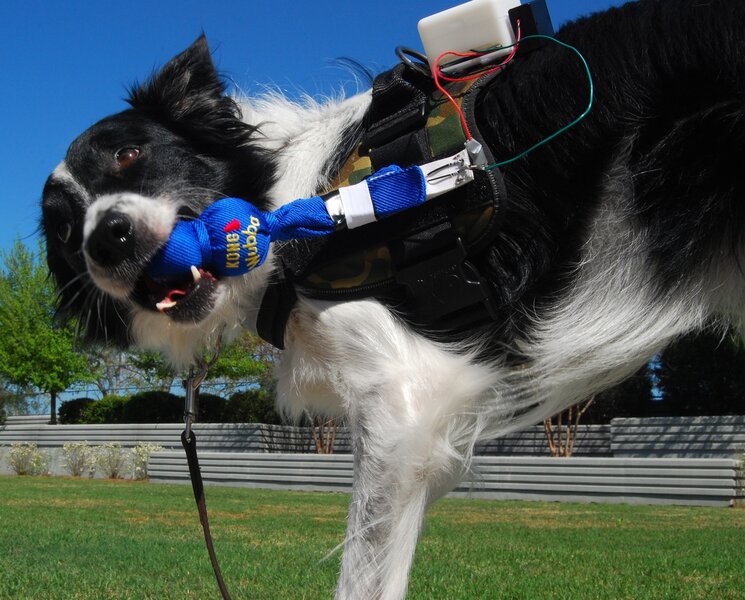FIDO: How a computer vest can help dogs 'talk'
Loading...
From Google’s computerized glasses to a sundry array of smart watches, mini-computers are cropping up everywhere to make our lives easier. And while it might seem a tad fantastical to start training dogs to use wearable computers, it’s a possibility that’s not so far off.
A team of researchers at the Georgia Institute of Technology has been developing a computerized vest for dogs called FIDO, “Facilitating Interactions for Dogs with Occupations,” that is meant to help handlers communicate with their service dogs.
The device looks like a typical service dog vest that hugs the canine’s shoulders, and back, fastening under the dog’s belly. The FIDO model has a compact computer with a microprocessor that sits between the dog’s shoulder blades with several pull toys or buttons that hang off of the side.
Dogs are trained to recognize things – such as bombs or a tornado siren – and depending on what each dog has been trained to detect, it then tugs on one of the pull-toys, or presses a button, sending a signal through the microprocessor to alert the owner to a certain danger or obstacle.
The alert system will depend on the dog owner’s needs, though researchers are still fine-tuning exactly how the owner will be alerted to what the dog sees, hears, or smells.
A recent grant from Google Glass team to the Georgia Institute of Technology has provided researchers with the opportunity to explore ways in which these computerized glasses can link to the dog’s computer. However, not all canine computer systems will connect to a handler via smart glasses, such as Google Glass; researchers are exploring other technologies that can link dog and human in ways that best fit the handler's needs.
Professor Melody Jackson from the Georgia Institute of Technology came up with this idea when one of her students told her about an incident with his guide dog. The student, who is visually impaired, was walking with his guide dog on the institute’s campus, when the dog stopped suddenly on the sidewalk. “The dog said ‘nope,' ” Ms. Jackson recalls her student saying. The student then took out his plastic cane, tapped in front of him, and, seeing no obstructions in their path, ordered the dog to proceed.
Both owner and dog walked into wet cement. The service dog had been unable to communicate with his owner that, while there was no imminent danger ahead, there was certainly sticky discomfort.
Jackson began talking with her colleagues, Thad Starner and Clint Zeagler, about different kinds of computer devices that could help communication between service dogs and their owners. Mr. Starner is a professor at Georgia Tech, as well as the Technical Lead and Manager of Google Glass, and has a background in designing wearable technologies. Mr. Zeagler has a background in industrial design and integrating computer technology into functional fashions. The team’s collaboration led to the creation of FIDO.
With the FIDO device, Jackson says that service dogs could more deftly warn owners about hazards in their paths – from wet cement to more life-threatening obstructions.
“It’s all just dog training,” says Jackson. In addition to her work as a professor and researcher, Jackson trains service dogs. It’s a matter of getting the dog’s observations to a language that the owner understands, she says. Despite a lap dog’s lackadaisical interpretation of “sit" or "stay,” service dogs – especially breeds like retrievers, poodles, and border collies – can understand upward of 1,000 words and 50-60 commands. Integrating computer systems that register and process what a dog’s tug or bark means, while not easy, is certainly feasible, says Jackson.
The applications for this kind of technology are endless, Jackson says. With the FIDO vest, a seizure-detecting dog could notify a patient’s family during the onset of an epileptic episode, she says. Dogs could activate a computer device on their backs with the tug of a rope, and the computer could send alerts to the patient’s family and doctor.
Or, with a bomb-detecting dog, the dog’s vest could be set up with haptic technology that would guide the canine based on a series of vibrations, allowing the handler to remotely navigate the dog. The dog could then send back signals to the owner using pull-toys or buttons on the vest.
And, adds Jackson, dogs could also be trained to alert their owners to whether or not stairs go up, or down, or if there is cement ahead.
[Editor's note: The original version of this article misstated the total number of commands that a dog can understand. An average dog can understand about 1,000 words and 50-60 commands.]








